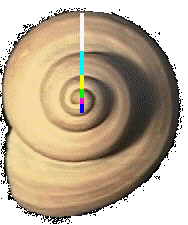 and stumble upon the fact that no matter what number you put for "x", you end up with the same number? (Ok, I seriously doubt you have, but if you did that, you would always end up with a number called phi.)
and stumble upon the fact that no matter what number you put for "x", you end up with the same number? (Ok, I seriously doubt you have, but if you did that, you would always end up with a number called phi.)Phi is a very interesting irrational number usually represented by the Greek symbol
 . Like pi, phi continues on to infinity with its first several digits as follows: 1.618033988749. This peculiar number can be found in the makeup of people, animals, nature, and geometry. By many Christians, phi is also know as the divine proportion since it seems to be the building block of nature used by God. Phi is most commonly called the golden ratio, but it is also known as the golden mean, mean of Phidias...
. Like pi, phi continues on to infinity with its first several digits as follows: 1.618033988749. This peculiar number can be found in the makeup of people, animals, nature, and geometry. By many Christians, phi is also know as the divine proportion since it seems to be the building block of nature used by God. Phi is most commonly called the golden ratio, but it is also known as the golden mean, mean of Phidias...On a person, if you take the length of their shoulder to their fingertip divided by the length of the elbow to the fingertip, you get phi. For example, I took a measure of myself: the length of my arm was 27.5 inches and the length of my elbow to my fingertip was 17 inches. Then if I divided the lengths, I got approximetly 1.6176 inches which is very close to phi. Other parts of the hand, face, and body can be divided by each other to equal phi also. This is a fun thing you can try out too, but try to measure as exact as you can.
An example of phi in geometry can appear with a regular pentagram:

Red ÷ green, green ÷ blue, and blue ÷ pink all equal phi.
Mathematicly, phi is also the only number that its square equals one plus itself:

This is very different from any other number. At first glance, this might seem impossible, but on closer inspection, with the help of a handy-dandy calculator, this equation works.
Phi can also be used in these equations, which no other number can:
 and
and  .
.This one looks really cool, but sadly, I have no earthly idea of what it means:
 .
.Yet another way to show phi is by looking at this simple pattern: 1, 1, 2 , 3, 5, 8, 13, 21, 34, 55, 89, 144, 233, 377, 610, 987, 1597, 2584...
Can you see the pattern? Each previous two numbers in this pattern added together equal the next number. Now for phi to come in. Divide two numbers next to each other. The result is a number approximate to phi. The further you go down the pattern and divide the two numbers, the closer the quotient is to phi. This addition pattern is known as the Fibonacci Sequence.
The pictures following are examples of creatures who exhibit phi:


 .
.In our world, phi isn't just a random number made up by some guy, rather is a number that God chose to build His world with.
"Measure what is measurable, and make measurable what is not so."
--Galileo Galilei
For more information, go to http://goldennumber.net/.
~ Alec
I hope this was interesting, if you have any questions, please feel free to comment.


 ^^^^^^^^^^^^^^^^^^^^^^^^^^^
^^^^^^^^^^^^^^^^^^^^^^^^^^^




 This continuous curvature can be found in many natural things like pine cones, sunflowers, chambered nautilus etc.
This continuous curvature can be found in many natural things like pine cones, sunflowers, chambered nautilus etc.
This comment has been removed by the author.
ReplyDeleteWow! Even I can't figure that out! I love the blog!
ReplyDeleteAlec, you are a mathematical genius! You are destined for greatness with that brilliant mind of yours! Impressive "random topic" of your choosing. Your words are eloquent and easily understood. I am impressed that you are able to look at all of these facts with a Christian perspective. Well done!
ReplyDelete~Mrs. A
Hey Alec its Hunter! I think it is awesome that you know all that math stuff don't think i will ever know that unless I have to.
ReplyDelete